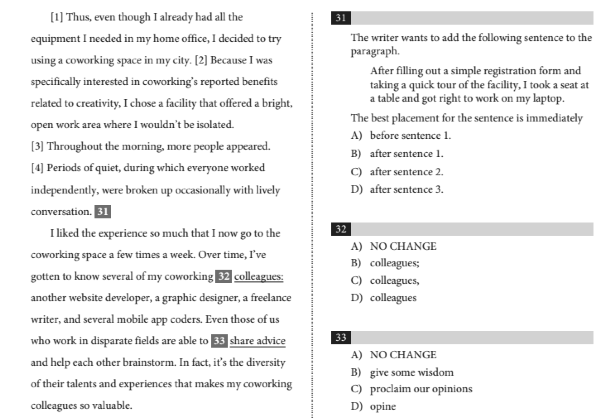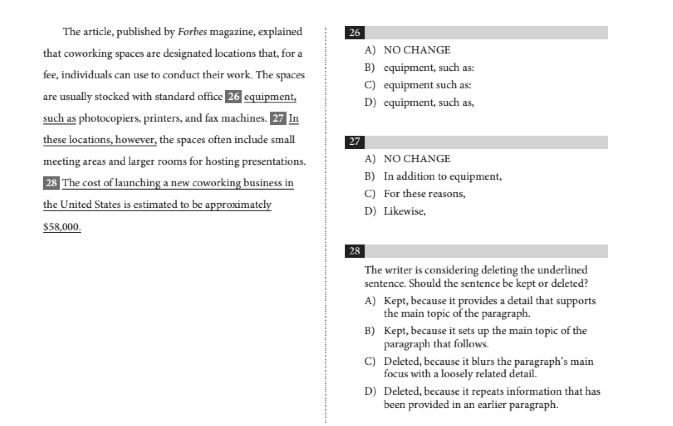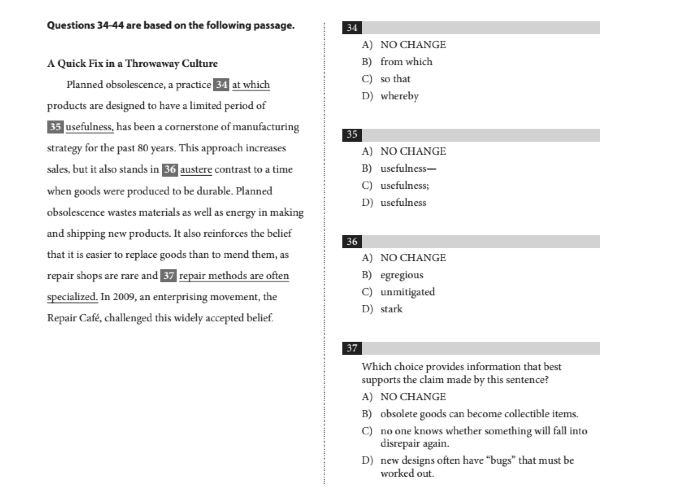
The format of the SAT Writing section is very unique, and you may not have taken a test with a similar format. To reach your target score, you're going to need a specific approach to tackle the passage-based questions.
In this article, I will explain the various approaches you can take when reading the SAT Writing passages, and I'll guide you on how to identify the strategy that will work best for you.
Why Do You Need a Specific Approach to Reading SAT Writing Passages?
The format of the SAT Writing section is unique and determining which approach will work best for you will help you combat likely mistakes. Some students only look at the underlined portions of sentences without understanding their context. Another common mistake is to rush through the section and make careless mistakes.
Having a tested approach will help you maximize your efficiency. Regardless of the approach you take, you should always read the complete sentence that contains the underlined portion. Also, you have to be consistent. Once you decide the best approach for you, use that approach on all your practice questions.

Omar Reyes/Flickr
The Top 4 Strategies for Reading SAT Writing Passages
These are the different approaches you can take to reading the passages.
#1: Paragraph-by-Paragraph
For this approach, you read each paragraph, and then you answer the questions in that paragraph. The benefits of using this approach are that you’ll understand what’s going on in the passage before you answer questions, and you’ll be forced to read full sentences before answering questions.
The main drawback of this approach is that it can be time-consuming. I recommend trying this approach on a practice section and seeing if you’re able to finish the section in 35 minutes. If you only need a couple extra minutes to finish, this approach can still work for you because you'll probably speed up with repeated practice. If you don't feel comfortable or confident being able to finish using this approach, you may want to use one of the other strategies I'll discuss.
Let's go through how the paragraph-by-paragraph approach works using a practice SAT Writing section.

If you were using the paragraph-by-paragraph approach on this section, you would read the entire paragraph up until “conversation” and then do question 31. This approach would work well here because question 31 requires an understanding of the paragraph.
Then, you would read the next paragraph before attempting to answer questions 32 and 33. On the SAT, you would repeat this process for each paragraph in each passage.
In case you're curious, I've provided the answers to these questions.
Answers: 31. C, 32. A, 33. A

Paragraphetzel (Windell Oskay/Flickr)
#2: Answer as You Go
In this approach, you read through the passage, and when you come to an underlined portion, you read past it to the end of the sentence. Then you answer the question before continuing. The benefits of this strategy are that it’s straightforward and fast. It’s a good strategy to try if you find yourself running out of time on the paragraph-by-paragraph approach.
The biggest drawback of this strategy is that you may have trouble answering questions about paragraphs and transitions that require a more thorough understanding of the passage. Personally, I like to use the answer as you go approach, but when I come to a question that requires me to read more of the passage, I continue reading until I have enough information to correctly answer the question.
You can also save the questions that require a more complete understanding of the passage until the end when you’ve answered the other questions and have completely read the passage.
If you use the answer as you go strategy, make sure you read until the end of sentences before answering questions.
Here’s how to use this approach correctly:

If you used this approach, you would read the paragraph up until “machines” before doing question 26. After completing question 26, you would read the next sentence until “presentations.” Then you would do question 27. Finally, you would read the final sentence of the paragraph and then do question 28.
For question 28, you may need to refer to the earlier paragraphs or the paragraph that follows to eliminate answer choices. However, for this particular question, because you will have read the entire passage up until this point, you can correctly answer this question without doing any additional reading.
While this approach is quicker, it can lead to more errors if you’re unable to recognize when you need to do more reading to correctly answer questions.
Answers: 26. A, 27. B, 28. C
#3: Sentence-by-Sentence
In the sentence-by-sentence approach, you only read sentences that include underlined portions. This strategy has significant drawbacks because you won’t comprehend the passage as well, and that may make answering some of the writing style questions that require a more thorough understanding of the passage rather difficult.
I don’t recommend using this approach if you’re shooting for a 650 or above on Reading and Writing. However, if you find yourself running out of time using other approaches or you’re getting distracted by irrelevant details, this could be a good approach for you. Just make sure you’re reading the entire sentence.
Let’s take a look at this approach in practice:

Read the first sentence and then do questions 34 and 35. Then read the next sentence and do 36. After, you can skip the sentence that starts with "Planned" and read the sentence containing 37 that starts with “It also reinforces.”
Again, if you encounter a question that requires a more thorough understanding of the passage, you can skip it and come back to it later, or you can read more of the passage until you know enough to answer the question. If you’re using this strategy, follow this approach for each question in every passage.
Answers: 34. D, 35. A, 36. D, 37. A
#4: Passage First
The last approach is to skim the entire passage, and then go back through using sentence-by-sentence to answer the questions. This strategy is the most thorough, and it can be helpful if you find yourself having trouble on the organization or big picture questions. However, this approach can take too much time and be trouble than it’s worth.
If you're a fast reader and have the most difficulty with the organization and content-based questions, this approach can be beneficial. If you struggle with time or feel more comfortable answering the questions as you read the passage, then this isn't the ideal approach for you.

How to Find the Right Strategy and Use It Effectively
Here are the steps to go through to figure out which approach to use.
Step #1: Try Paragraph-by-Paragraph
For most students, this approach will yield the best results. It may not be the best one for you, but try it first to see how it works.
Step #2: Analyze Why You’re Missing Questions to Decide on the Best Approach
After you finish your practice section, go over it very carefully; figure out why you got questions wrong and where you struggled. Make sure you know how to review practice tests. Think about these questions to decide which approach to try:- Did you run out of time?
- If you’re running out of time with 5 or fewer questions left, try the answer as you go approach.
- If you’re running out of time with 6 or more, try sentence-by-sentence.
- Do you have time left over? How much?
- If you have more than 3-4 minutes left at the end and you’re missing questions, you need to slow down. You’re probably rushing. Make sure to read the passage and questions carefully.
- Are you missing a lot of the big picture questions that ask about entire paragraphs or the passage as a whole?
- If so, you may want to focus on your reading comprehension and attentively reading the passage.
Based on your answers to these questions, decide which approach is best for you, and then practice that approach. It may take a couple of attempts to figure out what works best for you. Remember that regardless of which approach you take, you need to read the whole sentence before answering questions.
Step #3: Practice Your Approach Repeatedly
Once you decide on an approach, use it on every practice test and question. The purpose of having a designated approach to the passages is to enable you to correctly answer the questions as efficiently as possible. If you’re having difficulty maintaining a certain approach, you may want to try another one that’s easier for you to follow.
It may take some time to find the best approach for you, but once you find it, you’ll be able to maximize your score. These approaches only work if you use them consistently.
What's Next?
If you're trying to master the content for SAT Writing, make sure you know the 12 most important grammar rules. Also, you're going to want to review my articles on punctuation and transitions.
For those of you aiming for perfection, get expert advice from a perfect scorer on how to get a 1600.











